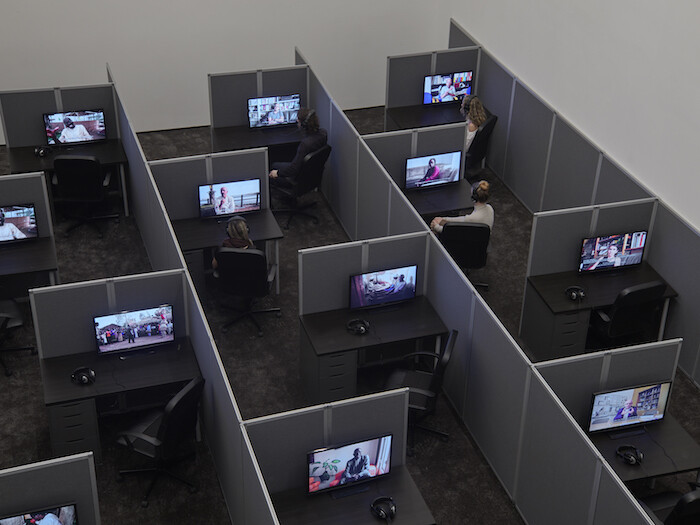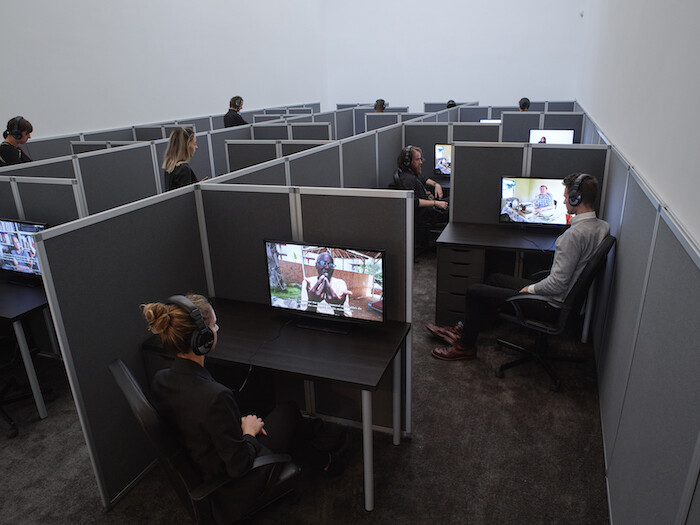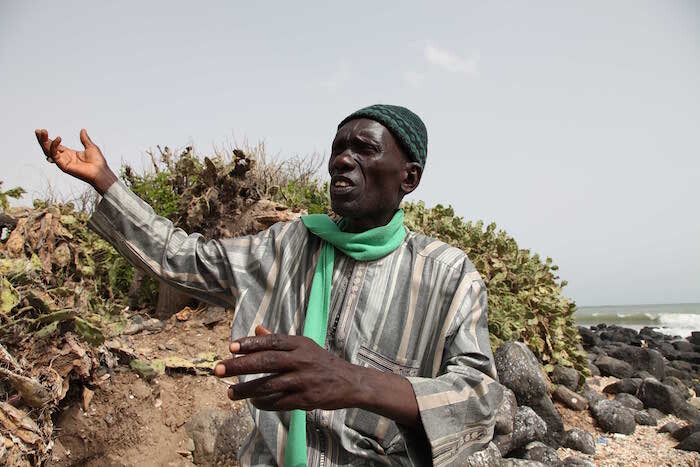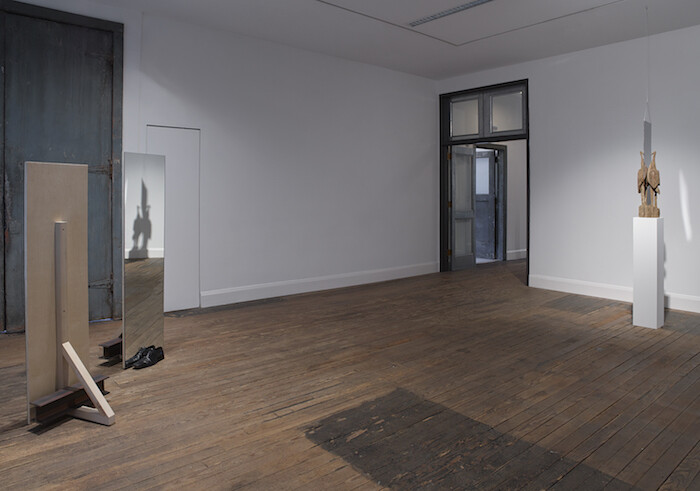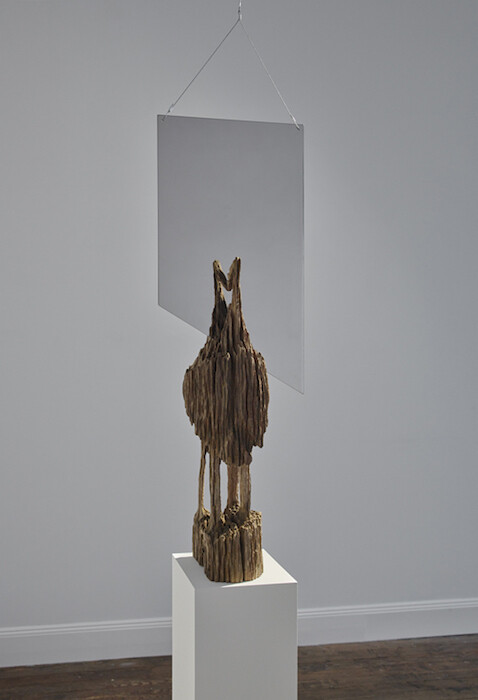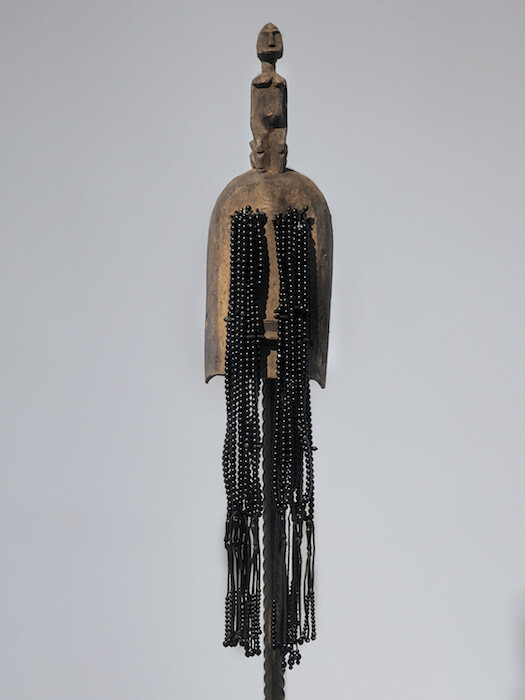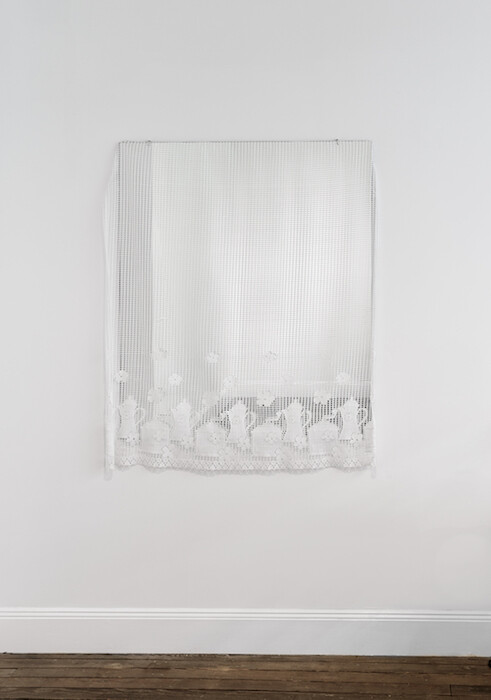Despite their enigmatic, aloof character, most of the works in Kader Attia’s current exhibition at Lehmann Maupin are relatively easy to make sense of. Whether in their medium (neoconceptual sculpture), their mode of facture (readymade assemblage), or their topic (cultural hybridization), they exemplify what we now expect of “global contemporary art.” This isn’t meant pejoratively; the sculptures are poetic, spare, and subtle, compelling attention while frustrating reductive interpretation. They show why the artist is receiving ever-broader acclamation, and they make clear that he deserves it. Attia’s inventiveness and spatial intelligence are evident from the show’s outset, most memorably in an arrangement of Styrofoam packing materials upon a wooden table (Untitled, 2017), a piece that looks like it might have taken minutes to assemble but that reads as a mordant update of Constant’s designs for New Babylon (1959-74).
By and large, the other sculptures in the show successfully achieve the objectives they seem to set for themselves, reworking established tropes of the Western neo-avant-gardes by interrogating their assumed universality; the precedent of artists like Jimmie Durham and David Hammons is clear. With that said, the piece that stands out is the one that doesn’t really work, at least not in the way art is typically assumed to work. This self-contradictory aspect is clear in its title (Reason’s Oxymorons, 2015), and even more so in its borderline impossible objective: to conduct exploratory research into the relation between Western European modernity and some of the numerous cultures that have served as its Other. The terms of this investigation are sprawling, even utopian: the time frame ranges from initial colonial encounters to the present; the geographic focus centers on sub-Saharan Africa (but is not limited to this already enormous region); and the definition of culture includes not just art, music, and narrative, but ontology, sociality, ritual, religion, bodily sensation, and collective trauma.
Such concerns are not themselves new; they were in fact the subject of Anselm Franke’s pivotal 2010-2013 set of exhibitions “Animism: Modernity through the Looking Glass,”1 which constellated critical scholarship, research-based art, and artist-theorist collaborations. What distinguishes Attia’s approach is his diverse, engaging roster of collaborators, which includes historians, philosophers, anthropologists, psychoanalysts, and traditional healers and shamans. Many of these people are positioned between former colonial centers and their subjugated territories; some of them work as ethno-psychiatrists or as psychologists treating migrants and refugees.
After recording video interviews with these individuals, Attia edited their responses into 18 groups under such headings as “Exile,” “Genocide,” “Trance,” and “Modern Science and Traditional Therapy.” These compilations then became part of a massive, maze-like multi-channel installation, which used generic store-bought workstations and office partitions to construct a warren of individual viewing cubicles. If this environment clearly recalled the atomized, coercive architecture of the huge conglomerates that operate across global divides—not just multinational corporations, but also aid organizations and NGOs—it also brought to mind the much more modest space of a university A/V library.
However coincidental, this resemblance spoke to the work’s reliance on documentary, archival, and didactic procedures: modes quite distant from the relative formalism of the sculptures Attia was showing. It’s debatable whether this difference marks a stylistic discrepancy or a more radical contradiction; much more could be said about the critical stakes involved in such questions, which might seem confined to terminology but ultimately concern nothing less than the sociohistorical ontology of art. Yet regardless of how one views such matters, it seems clear that the effectiveness of works like Reason’s Oxymorons depends on how they negotiate the tensions between how art looks and what it means or says or does.
In the case of Attia’s installation, resolving this question meant evaluating how the piece worked on two planes: both as art and as research. For this viewer the work’s material, sculptural dimension seemed secondary, not so much an afterthought as a means toward an end. Its artistic character resided rather in the labor of conceiving and executing the project—a more difficult (and interesting) object of judgment. On that score, the most successful part of the piece wasn’t so much the manner in which the videos were recorded or grouped or edited, but the way the artist was able to find compelling speakers and elicit their stories and thoughts. While sculpture is still often described with an implicitly gendered rhetoric of agency—sculptors carve, find, construct, assemble, install, and so on—Attia’s approach made clear that sculpture can also depend on attunement, empathy, and listening, or on the spatial arrangement of narratives and concepts. This stance assumed a particular resonance in light of the artist’s ongoing interest in the practices of repair and reparation, and the meanings such activities can have in the context of intercultural encounter, violent or otherwise.
Similarly, when it came to research, the interesting aspects of Reason’s Oxymorons weren’t what one might expect. Whether as history or ethnography, as theory or reportage, Attia’s recordings didn’t supply much new information, and they seem unlikely to change the thinking of anyone familiar with these complex, much-studied subjects. Several crucial topics weren’t really dealt with head-on or in meaningful detail: the continuing impact of colonization and decolonial struggle; the politics of neoliberalization under regimes of global governance; the relation between migration and the emergence of new nationalist and quasi-fascist regimes in the global North. It was strange to find hardly any discussion of Frantz Fanon, given his irreplaceable contributions to the fields of ethno-psychiatry and postcolonial studies. Without more clarity on such matters, it was hard to discern a stable argument within the piece or to regard it as a decisive critical intervention.
Despite these shortcomings, many of Attia’s subjects spoke in ways that were both erudite and poignant, deploying established Western concepts even as they questioned them; such an approach conveyed a different kind of knowledge than the sort of quantifiable “outputs” that the term “research” often connotes. An anthropologist explained how certain Mesoamerican cultures lack the concept of an afterlife: for them, “the dead dissolve.” A Cameroonian psychotherapist convincingly demonstrated how a traditional African saying proves the existence of an indigenous concept similar to what Sigmund Freud would much later theorize as unconscious projection. A Rwandan psychiatrist who survived the genocidal violence in her country reinterpreted the work of Primo Levi in a moving account of her own struggle with nightmares and flashbacks.
These voices linger in one’s mind well after leaving the show, along with seemingly insignificant details, like the strangely empty drawers in all those desks. Ultimately, that fact seems much more important than the questions of what kind of art the installation is, or whether it’s successful in the terms we typically apply to art. It seems fair to think of Attia’s recent work in the same terms many researchers use for their own activities; on this view, Reason’s Oxymorons reads as something like an interim progress report from a much longer project. One hopes that Attia can find ways to bring the thoughtfulness of his video investigations into closer contact with the refined but somewhat safe aesthetic of his sculptures. If he succeeds in doing so, he could produce work that might transform not just how we judge particular artworks, but how we think about art, the way art “thinks,” and the powerful role it plays in our own thinking.
“Animism” was a cooperation between Extra City – Kunsthal Antwerp; Museum van Hedendaagse Kunst, Antwerp; Kunsthalle Bern (2010); Generali Foundation, Vienna (2011); and Haus der Kulturen der Welt, Berlin (2012), later also presented at e-flux (2012), and the Ilmin Museum of Art, Seoul (2013-14).
